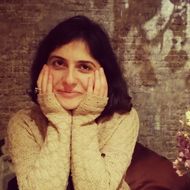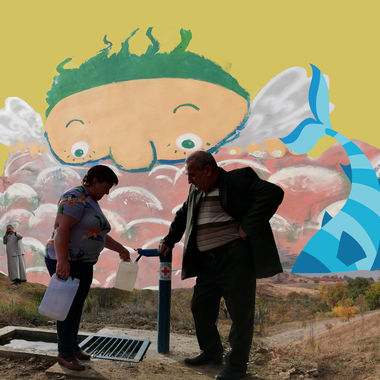
New Julfa, St. Bethlehem Church, consecrated in 1628, on the left. The Church of the Holy Mother of God, consecrated in 1613, on the right.
Image Source
This time around there was no hitchhiking. This time around I needed to behave, I was a khanum.
One day when I opened the door to my hotel room, I had forgotten to put on a headscarf. I did not speak their language and the (male) hotel employee did not speak mine, or English. Before I could understand what was wrong, my roommate came to my aid with a scarf and I understood that the misdeed had been done.
On that trip I learned what a squat toilet was and how there could be a water hose instead of toilet paper. They say it is more sanitary that way, God loves cleanliness and people here love God.
It was the middle of autumn when I arrived in Iran. Until then, Isfahan was perfume in a blue flask on my mom’s boudoir. But then, in mid-autumn and ever since, Isfahan became an Eastern splendor in the middle of the desert, a large square, a marketplace with women wrapped in scarves, men with well groomed nails, a place with an abundance of blue, hospitality and diplomacy.
For me, Isfahan is now also the Armenian neighborhood - Julfa. In contemporary lexicon, Julfa would be what we would call “the old city” despite the insistence of some that Julfa is rather the Champs Elysees of Isfahan and Isfahan is half the world.
The architect of this melting pot was Shah Abbas. Around 400 years ago he built a new capital for his empire right in the center of the country and populated it with Armenians from Jugha.* These Armenians were farmers, merchants of the Silk Road and advisers to the Shah himself. Armenians still live there, though not as many as before.
A Stroll in the Armenian Neighborhoods of Julfa
After the not so velvet revolution in 1979, relations between Iran and the United States deteriorated and the two countries are not on good terms. Despite this, there are some within the Armenian community of Isfahan who “love” President Donald Trump like Rima Simonian, the vice principal of the Kananian School. She half jokingly explains, “He stopped migration out of Julfa, closed the doors and did well in doing so. We stopped leaving.”
There are about 4500 Armenians who have still not left Isfahan. Simonian is sure, they will be able to overcome the financial crisis in the country. She believes the 400-year-old community cannot vanish. She herself has lived in Europe, in other cities in Iran but will not exchange any of them with Julfa.
The Only Mixed-Gender School in Iran is an Armenian One
Armenian children in Julfa study at the Armenian national educational complex. The complex is home to five institutions where approximately 380 children receive an education - a kindergarten, a pre-school, the “Armen” elementary school, the Katarinian all-boys’ and the Kananian all-girls’ school.
I visited the complex and found out that only Armenians study here. A student, Lilit Gevorgian said that they study all the same things as in Iranian schools save the Quran.
Incidentally, for just over a year now, the educational complex has become a mixed-gender school. It is important to understand, this is an exception in this country where even at a hotel the male and female rooms are in different wings and where men and women do not sit next to one another on public transport unless they know each other. The mixed-gender school is the result of the efforts of the school’s administration but as such, Armenian schools here are not new, they have been around since the 17th century.
The old buildings of these schools are still standing though out of safety concerns, they have not hosted students for almost eight years now. But the feet of those who seek will take them to those buildings and their eyes will not have enough and their mouths will fall ajar in astonishment. The story is the building itself, the interior, the wooden ceiling, the courtyard, the bread oven in the courtyard. A friend, after seeing the photos, said the place looked like a “cinematic set.” My whole trip was a cinematic experience.
The Melting Pot of Three Cultures
And if we continue the discussion about architecture, let me tell you that in Julfa, the domes of churches are not pointed but rather round like a Mosque’s. It was the order of Shah Abbas - do not emphasize religious minorities on the landscape of widespread Islamization. Still, you will find the Armenian and a bit of the European inside the church.
“Those who saw these murals were the rich, the merchants who traveled to the different countries of Europe. It was their idea to decorate and beautify the walls and at the same time, convey Biblical teachings to the people through images,” explains Tovma Galstanian, the archivist at the St. Nerses Shnorhali Library.
The feet of those who seek will eventually also lead them to the monastery and their eyes will discover the library at the 400-year-old Holy Savior Monastery.
They will also find the Khachatur Kesaratsi Museum and the old black printing press on display. This would be the first Gutenberg press in all of Iran, the very printing press that spread the advance of printing in the Middle East.
Not Only Armenians Learn Armenian
The sheer scope of the university in Isfahan, resembles a whole city. If you don't feel like walking an hour from one faculty to the other, then wait at the bus stop, the bus will come.
Here, at the faculty of foreign languages, they also teach Armenology. The students are Armenians as well as Iranians, they learn Armenian language, literature and history. The department even publishes its own literature in Armenian and on the Armenian language.
border villages in Armenia
The Fairy Tale: Would You Believe It?
By Arshaluys Barseghyan
The only thing this fairy tale needs to become a reality is peace and peace perhaps needs a fairy tale.
The Last Station: Friendship
Now, you must promise me that if your feet ever take you to Isfahan, you’ll go to Julfa and once there, you’ll visit the Ararat Club. It is a mini-Armenia where the entire community gathers for sporting and cultural events.
Women don’t wear headscarves inside its walls. It was unbelievably enjoyable, that same feeling of walking down the middle of a large boulevarde instead of along the sidewalk. I felt a limitless sense of permissiveness surrounded by all that abstention.
The Armenian community here still does not have the answer to the question: was it good that 400 years ago in the face of such difficulties, they were moved here or would it have been better had they stayed in Jugha? Though the situation there was not better … there was Ottoman Turkey, the constraints ... had they stayed they could have integrated or maybe not, who knows.




